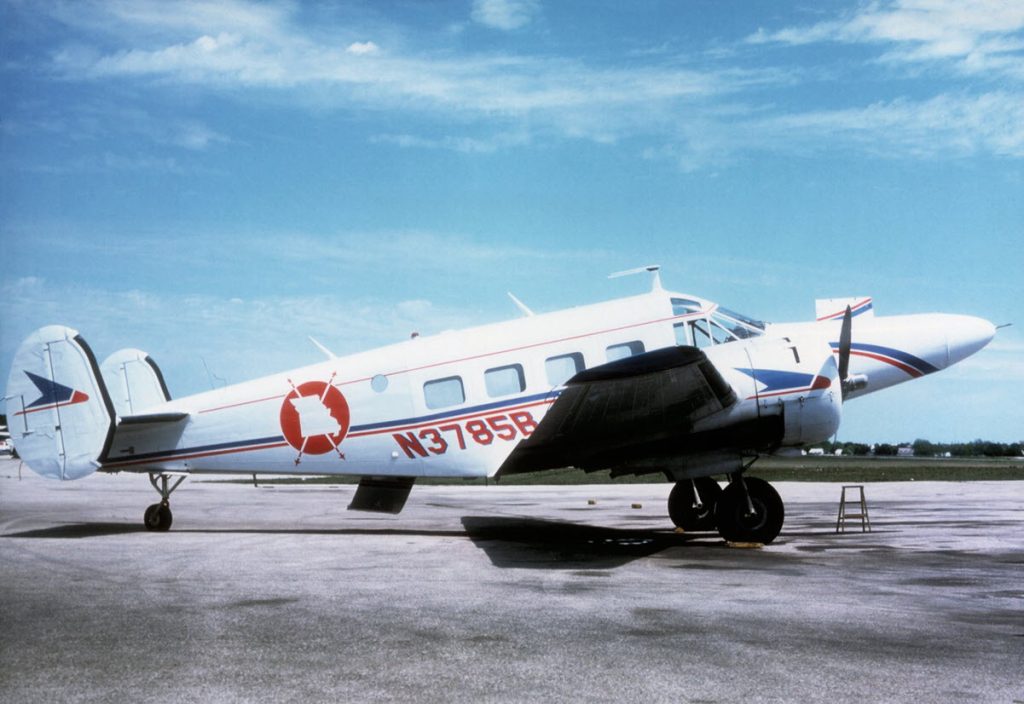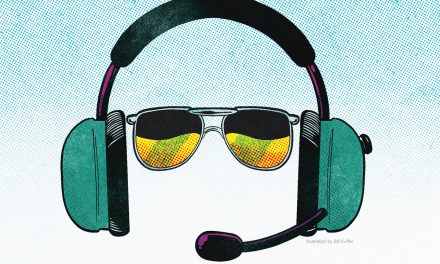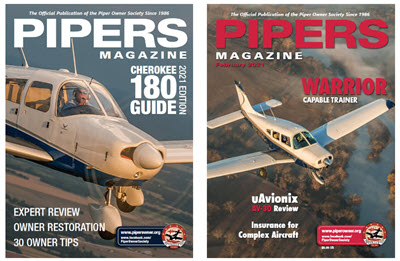
November 19, 1973, was cold and rainy at Fort Leonard Wood, Missouri, where I was employed as a 23-year-old copilot with a local airline. The airline was a small but vibrant commuter airline that operated a fleet of Beech 99 turboprops, Beech 18s, and several single engine airplanes of various lineage. We would add a DC-3 a year later. My duties included copiloting the Beech 99 and Beech 18, as well as pilot in command of the single engine airplanes.
A Demanding Day
On this particular day, I was scheduled to fly a Beech 18 with Captain Jerry. Jerry had been my chief pilot and multi-engine instructor at an FBO in Springfield, Missouri, where we both worked prior to our employment at the current company. Jerry and I had flown together often in the past and now, by a quirk of fate, we were once again flying together. I had always admired Jerry and rated him as an excellent pilot.
There was one other, less fortunate thing we had in common. We were the last pilots hired, which put us at the bottom of our respective seniority lists. Jerry was the most junior captain, while I was the most junior first officer. That put both of us on the bump spot when it came time for furloughs.
But this rainy afternoon, neither of us was contemplating our future. We were scheduled to fly the afternoon shift in a Beech 18 over the eastern half of our route system, and it promised to be a long and difficult day. We would fly 12 legs, which would equate to nearly eight hours of flying, without the aid of an autopilot. But what would make this a really long and stressful day was the weather.
It was a cold, miserable day over the entire Midwest with a steady rain falling and temperatures in the low 40s. The forecast called for IFR weather over our entire route, all day. Ceilings were 400 to 700 feet while visibilities varied from one to four miles in rain and fog. This would necessitate an instrument approach at every stop along our way, all 12 approaches. Ten of these would be non-precision VOR and fixed card NBD approaches flown to minimums in a non-radar environment. To add to the stress, we would be flying on instruments not just during approach, but for the entire enroute phase as well. For someone like me who needed experience, it was a blessing. Nonetheless, it would be one tough, long day.
Our Beech 18s were classic, early 1950s, radial engine tailwheel airplanes that held a total of nine passengers and a crew of two. They were beautiful old airplanes and we were proud to fly them. The only drawbacks were the noise level in the cockpit and the lack of an autopilot. We hand flew them every minute of every flight.
I met Jerry in the crew briefing room and we flight-planned for the day’s activities. This consisted of two round trips throughout the eastern half of our route system. The first flight would take us from Fort Leonard Wood to Lake of the Ozarks, to Rolla, St. Louis, back to Rolla, then to Lake of the Ozarks, terminating at Fort Leonard Wood. After a short break to refuel and flight plan, we would fly the same route again.
Added Pressure
With the weather checked, flight plans filed, and all paperwork complete, Jerry and I walked out of flight operations and headed for the airplane. However, as we passed through the flight office, the company president called us into his office. He shut the door behind us and commenced in his slow Missouri drawl.
“Well boys, it’s late November now and our seasonal business at Lake of the Ozarks has peaked and fallen off. We’re losing money which means I’ll have to furlough some pilots for the winter. Since you two are on the bottom of the list, it looks like I’ll have to let both of you go.”
It was news I had been expecting and it really didn’t bother me. I could work on the ramp loading bags and fueling airplanes until spring when I would get my copilot job back. I was living in a hundred dollar-a-month mobile home and had no kids or bills. For me it would be no problem, but for the captain, it was a different story. Jerry had just signed a lease on an apartment, his wife didn’t work, and she was 8 months pregnant. It was a problem for Jerry!
As the bad news registered in Jerry’s brain, his face flushed with anger. He looked the company president in the eye and said, “Furloughed? Effective when?”
The president replied laconically, “Why, tonight, when you get back.”
Tonight? No notice? Didn’t our boss consider how this bombshell would affect us emotionally just before heading out to fly all day in bad weather? But to the president, it was nothing more than a business decision. With his company losing money, there was no room for sentimentality. Jerry and I, with a combined salary of $1,400 per month, were simply excess financial baggage that needed to be unloaded.
Jerry lost his composure and began shouting obscenities that, at the moment, rather accurately described our boss. I was afraid Jerry might start throwing punches so I suggested we would be late for departure if we didn’t leave now. Not that it mattered anymore! The ruse worked, and Jerry followed me out of the boss’ office.
As we took our seats in the cockpit, it occurred to me that Jerry might be too angry to fly safely. It gave me momentary pause until I realized that I wasn’t upset, which would give us one cool head in the cockpit. Then a more comforting thought crossed my mind. I had known Jerry for a long time and knew he wouldn’t let his anger interfere with his flying. With this thought in mind, I resolved that we would meet our flying obligation for today and be alive to accept our furloughs tonight.
After settling into our seats, we began the before start checklist. Meanwhile, five passengers bound for St. Louis were boarded and took their seats. They would first have to accompany us to Lake of the Ozarks where we would board two more St. Louis bound passengers. With our checklists complete, Captain Jerry brought the two Pratt and Whitney R-985’s radial engines to life, in a cloud of smoke. As we taxied for takeoff, Jerry seemed to have calmed down a bit. However, I could still detect an undercurrent of anger just below the surface of his professional demeanor.
After an extensive engine runup, the tower cleared us into position on Runway 32. Jerry indicated that he would fly the first leg and we would alternate legs for the rest of the day. I locked the tailwheel and we were cleared for takeoff. The captain smoothly advanced the throttles to 36.5 inches of manifold pressure, the props stabilized at 2,300 rpm, and the roar of 18 cylinders making 900 horsepower assaulted our ears.
After liftoff, Jerry called for me to raise the landing gear. Soon thereafter we entered the ragged clouds at 400 feet. It was raining moderately in the clouds as Jerry set climb power and intercepted the VOR radial that would take us towards Lake of the Ozarks. Later, we would pick up the radio beacon at our destination and track it inbound, finishing the short, 50-mile flight with an NDB approach in a non-radar environment.
Captain’s Orders
A short while later we leveled off at 4,000 feet in the dark and gloomy clouds. Flying on instruments, Jerry pulled the throttles back to 28 inches of manifold pressure, pulled the prop control levers back to 1,900 rpm and leaned the mixtures for cruise power. I closed the oil shutters to keep the oil temperatures in the green arc and reached for the carburetor heat levers. At that point, Jerry did a strange thing. With a wave of his right hand, he told me not to use carburetor heat! We were flying in conditions that were ideal for the formation of ice in the carburetors.
Our Beech 18 was equipped with carburetor fuel mixture temperature gauges. Both gauges indicated mixture temperatures solidly in the icing zone, as denoted by a yellow arc. The use of carb heat would prevent ice from forming in the carburetors. It would also remove any ice that had already accumulated, and its use in these conditions was mandatory. But Jerry, with no explanation, had just said no to its use.
A few minutes later, I checked the manifold pressure. Jerry had set 28 inches just moments ago but both engines were now indicating 27 inches. The loss of one inch of manifold pressure meant we were beginning to pick up ice in both carburetors. I waited for the captain to do something, but Jerry just sat there, lost in his thoughts.
A short time later I noticed the manifold pressure had fallen to 26 inches indicating that ice was accumulating rapidly in the carburetors. We had the means for removing it, but by the captain’s order, we weren’t using it. I was getting nervous about the situation, so I placed my left hand on the carburetor heat levers as a means of prompting Jerry.
I could have simply pushed the levers down and deiced the carburetors, but in 1973, there existed a strong code of conduct between captains and other crew members. You simply did not do something the captain had just told you not to do. With my hand on the levers, I looked at Jerry with words unspoken. Again, he waved me off with a hand gesture, but still didn’t explain his reason.
A few minutes later I was stunned to see just 25 inches. We had lost 3 inches of manifold pressure in less than 10 minutes, indicating a substantial accumulation of ice in the carburetors. Once again, I placed my left hand on the carb heat levers and looked at Jerry. His silence was finally broken with a terse command, “NOW!”
Knowing exactly what was about to happen, I pushed the two levers down to the full hot position. At the same time, Jerry leaned towards the center of the cockpit, turned around and looked into the faces of our five hapless passengers.
The ice-choked carburetors received a blast of hot air from the exhaust manifold. The ice melted creating a huge slug of water in the induction system of each engine. The water quickly flowed to the supercharger manifold where it was directed to the intake valves on all 18 cylinders. The result was that both engines immediately quit. The props were still turning at 1,900 rpm, but since water doesn’t burn, the cylinders weren’t firing. This resulted in total silence that replaced the raucous noise of the two radial engines.
After several long moments of silence, all the water was purged from the cylinders and replaced with fuel, and the engines roared back to life. The propellers surged wildly up to 2,300 rpm until the prop governors regained control and pulled them back to 1,900 rpm. The passengers must have been terrified by the noises; first, the steady roar of two radial engines hard at work, then silence, and now the engines sounded like banshees!
Why had Jerry done such a thing? Then a strange calmness seemed to come over him. With his anger dissipated, he sat upright in his seat, straightened his tie, and said, more to himself than me, “That’s FIVE sons of guns who’ll never fly this airline again!”
Mission Accomplished
So, the great carburetor ice mystery was finally solved! And Jerry was right, these passengers would never fly on this airline again. Incredibly, that’s how the rest of our long and difficult day went, with Jerry scaring the passengers by icing up the carburetors on every leg. He even kept score! By the end of the day, there were 42 sons of guns who would never fly on this airline again.
Late that night, after 12 hours on duty and 12 instrument approaches, we parked our Beech 18 on the ramp, cut the engines, and headed bleary eyed into flight operations. Our boss once again called us into his office and closed the door. This seemed vaguely familiar.
First, he informed us that one of our copilots had quit and left that day with no notice. My mind quickly saw the irony of no notice. Then he offered Jerry a job as copilot, which Jerry angrily refused. Jerry countered with a threat to sue the company for breach of contract and, after some heated exchanges, he agreed to let Jerry fly as captain for the rest of the month, 11 more days before his furlough went into effect. That still left the company short one copilot and the boss made me an offer I couldn’t refuse.
So, it all worked out to everyone’s satisfaction. The company had reduced its pilot staff, I had my job back, and Jerry had gotten revenge!
Postscript
While having both engines quit at the same time sounds dangerous, it was not. With engines the size of our 9-cylinder, 985 cubic-inch engines, and the 9-foot diameter propellers, there was no danger of the engines coming to a complete stop in flight as the result of a slug of water passing through the induction system. The sheer momentum of the engine’s rotating mass, along with the engine’s low compression ratios, assured the propellers would keep turning on speed until the water was purged.





